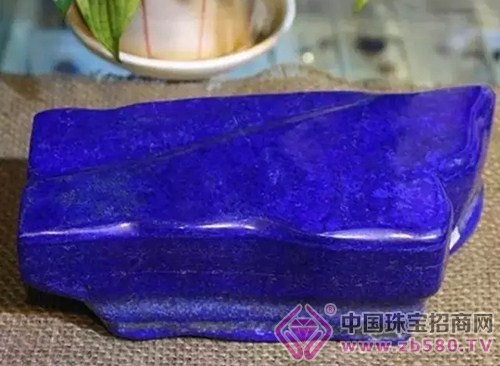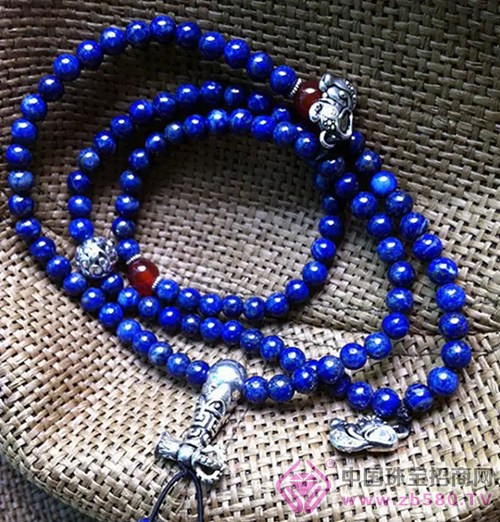
The international recognition of lapis lazuli has always been higher than that of China. China has always advocated jade culture and pays attention to the gentle and low-key beauty. Therefore, the acceptance of bright and colorful lapis lazuli is not as high as that of jade. However, in recent years, prices have continued to remain high, making the people's tolerance to jade products less, and consumers and businesses are constantly exploring new alternatives. Coupled with cultural integration and exchanges, people's aesthetics have also undergone a certain transformation. The lapis lazuli has not been heard from the original, and the price has soared to the present, but it has only experienced two or three years. At the 2014 Beijing Spring Jewelry Show, China Cultural Relics Network interviewed Zhou Zhenjun, the general manager of Man Lin's lapis lazuli store, and asked him to talk about why the lapis lazuli is so hot.
What is lapis lazuli?
Lapis lazuli is an opaque or translucent blue, blue-purple or blue-green semi-precious stone. The countries producing lapis lazuli in the world mainly include Afghanistan, Chile, Russia, Tajikistan, the United States, and Canada.
“The lapis lazuli is the national stone of Afghanistan.†Zhou Zhenjun said that the Saray Segguge deposit in Badakhashang Province of Afghanistan is the world’s oldest and best source of high-quality lapis lazuli raw materials, and is also the most famous. Old mineral materials.
The lapis lazuli is a multi-mineral aggregate, which means that it is composed of a mixture of many minerals, so the lapis lazuli products we see are often white, black, translucent or goldy. The golden impurity is pyrite, which is the "gold" of lapis lazuli. The more impurities, the greater the impact on the beauty of lapis lazuli products, so the price of lapis lazuli in the market is “no gold and no whiteâ€. If the pyrite is evenly distributed and star-shaped, it will bring a different beauty to the lapis lazuli. Such lapis lazuli is also recognized by the market.
Ancient foreign lapis lazuli is a symbol of power and wealth
In the ancient times without chemical dyes, all colors came from nature. Although the common and readily available plants were bright in color, the dyed colors could not be maintained for a long time. This makes all non-fading, natural-colored minerals particularly popular. The lapis lazuli is one of them. It has won the love of people of all countries with its dazzling blue.
Ancient Egyptian lapis lazuli is equivalent to gold. There are many lapis lazuli burial ornaments in the artifacts unearthed in Egypt. The lapis lazuli appears frequently in the poems of ancient Babylon. For example, the moongodsin is described in such a song: "The bull is strong, the big head, the perfect shape, the long hair, Like the lapis lazuli." Even the modern technology, turquoise, coral is a precious gem, and ancient India, ancient Iran and other countries, lapis lazuli and turquoise and coral. Ancient Greece and ancient Rome, wearing lapis lazuli is considered a rich Peugeot.
“The lapis lazuli has also been ground into powder and made into pigments. Many of the world famous oil paintings used in the Renaissance have used lapis lazuli,†said Zhou Zhenjun. Medieval monks also used it to decorate manuscripts. The pigment made of lapis lazuli is very expensive, and the work that needs to be used for it is also a very expensive job. It can be regarded as a rich Peugeot.
The lapis lazuli in the history of our country is a symbol of imperial majesty
The earliest use of lapis lazuli in China is still controversial. According to "Shangshu·Yonggong", as early as 4,000 years ago in the Xia Dynasty, the western Zhangzhou had tribute to the central dynasty, and Yulin was the Persian transliteration of the lapis lazuli.
Zhang Hongjun also supports this statement in Shiya, but it has not been confirmed because there is no archaeological discovery. At present, the oldest lapis lazuli products excavated in China are unearthed in the tomb of Zenghou Yi in the Spring and Autumn Period. It is another national treasure unearthed during the Spring and Autumn Period. The sword of Yue Wangjian is also inlaid with lapis lazuli.
Zhou Zhenjun said that the color of lapis lazuli is considered to be the color of the sky, and there is a saying that "hue is like the sky." "God" has supreme majesty in Chinese culture. The ancient emperor of China claimed to be "the Son of Heaven", so the lapis lazuli has a close relationship with the emperor since ancient times. According to the "Cultural Examination of the Qing Dynasty": "The Emperor Chaozhu ornaments, only the Temple of Heaven uses lapis lazuli, the altar uses amber, the altar uses coral, the moon altar uses turquoise; the emperor faces the belt, which is decorated with lapis lazuli and altar. Topaz, the altar uses coral, and the moon altar uses white jade." It means the pilgrims and pilgrimage belts worn by the emperor during the rituals. Anyone involved in the sacrifice of the heavens uses lapis lazuli. Not only that, Lapis Lazuli is also believed to be able to communicate with the world, let the deceased ascend to heaven, and to be buried in the lapis lazuli at the time of burial: "With its color, this is the use of the road to ascend to heaven", so lapis lazuli is often used. To make the emperor's funerary objects.

Why do modern people like lapis lazuli?
Zhou Zhenjun mentioned that in the "Shiya" record: "The lapis lazuli color is like the sky, or the complex gold shavings are scattered, brilliant, if the stars are in the sky." The idioms are full of "Lin" refers to the lapis lazuli. There are three reasons for the Chinese people to regain their enthusiasm for lapis lazuli: First, although China has always been the mainstream of jade culture, the color of lapis lazuli is deep and noble, and it is made into beautiful jewelry. In recent years, people’s aesthetic level With the improvement of economic ability, the understanding of lapis lazuli is gradually deepening, and naturally it will be attracted by the cultural connotation of lapis lazuli.
The second lapis lazuli is one of the seven treasures of Buddhism, and is the embodiment of the Tibetan Buddhist medicinal buddha. In particular, the accessories made of lapis lazuli beads are often worn with the blessings of Buddhism to protect the health and safety, and look forward to the good wishes of disease-free and disaster-free. Its Sanqing Golden Stone is a very spiritual item that can enhance its own refined temperament by being eye-catching, calm, and calm. Frequent wearing of lapis lazuli jewelry can alleviate the symptoms of insomnia and anxiety, and has a good therapeutic effect on headache and dizziness.
Jiangsu Hangfu Brocade Development Co., Ltd , https://www.eruditebedding.com